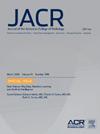Cost-Effectiveness of Follow-Up Imaging for Incidental Adrenal Nodules to Rule Out Adrenocortical Carcinoma
IF 5.1
3区 医学
Q1 RADIOLOGY, NUCLEAR MEDICINE & MEDICAL IMAGING
引用次数: 0
Abstract
Purpose
Several follow-up recommendations have been developed to assess the risk for malignancy of incidental adrenal nodules, but none has been validated in prospective trials. The purpose of this study was to develop a simulation model that evaluates the cost-effectiveness of follow-up imaging to detect adrenocortical carcinoma in adrenal nodules in patients with no known malignancy.
Methods
Using 1 million simulated adult patients with incidental adrenal nodules measuring 1 to 4 cm detected on contrast-enhanced CT, follow-up strategies were evaluated, including ACR and American Urological Association recommendations. Variants of the ACR recommendations using noncontrast CT only, or noncontrast MRI only, instead of washout CT were also evaluated. Costs and life years (LYs) were calculated for the simulated cohort. A probabilistic sensitivity analysis was performed by varying model parameters.
Results
In the base-case analysis, the only cost-effective strategy under a willingness-to-pay threshold of $100,000 per LY was the variant ACR recommendation using noncontrast CT only at the time of diagnosis ($241 per patient). The standard ACR recommendation with washout CT resulted in fewer LYs at increased cost. The probabilistic sensitivity analysis demonstrated that at the $100,000 per LY threshold, the variant ACR recommendation with noncontrast CT was cost effective in 50% of simulations, the American Urological Association recommendations (washout-disregarded variant) were cost effective in 20%, the variant ACR recommendation with MRI was cost effective in 16%, and no follow-up was cost effective in 10%.
Conclusions
Follow-up imaging with noncontrast CT for incidental adrenal nodules appears to be cost effective to rule out adrenocortical carcinoma. However, strategies using washout CT are not cost effective.
偶发性肾上腺结节排除肾上腺皮质癌的随访影像学成本-效果。
目的:已经制定了一些后续建议来评估偶发肾上腺结节的恶性风险,但没有一个在前瞻性试验中得到验证。本研究的目的是建立一个模拟模型,评估随访成像检测未知恶性肿瘤患者肾上腺结节中的肾上腺皮质癌的成本-效果。方法:使用1,000,000例模拟成年患者,在增强CT上检测到1 - 4cm的偶发肾上腺结节,我们评估了随访策略,包括美国放射学会(ACR)和美国泌尿学会(AUA)的建议。我们还评估了ACR推荐的变体,仅使用非对比CT,或仅使用非对比MRI,而不是冲洗CT。计算模拟队列的成本和生命年(LYs)。对不同的模型参数进行了概率敏感性分析。结果:在基础病例分析中,在支付意愿阈值为100,000美元/LY的情况下,唯一具有成本效益的策略是在诊断时仅使用非对比CT的变型ACR推荐(241美元/患者)。标准ACR推荐的洗脱CT导致寿命较短,成本增加。PSA表明,在100,000美元/LY阈值下:50%的模拟采用非对比CT的变异ACR推荐具有成本效益,20%的模拟采用AUA推荐(剔除变量)具有成本效益,16%的模拟采用MRI的变异ACR推荐具有成本效益,10%的模拟采用无随访的ACR推荐具有成本效益。讨论:偶发肾上腺结节的非对比CT随访成像似乎是排除肾上腺皮质癌的有效方法。然而,采用冲洗CT的策略并不具有成本效益。
本文章由计算机程序翻译,如有差异,请以英文原文为准。
求助全文
约1分钟内获得全文
求助全文
来源期刊

Journal of the American College of Radiology
RADIOLOGY, NUCLEAR MEDICINE & MEDICAL IMAGING-
CiteScore
6.30
自引率
8.90%
发文量
312
审稿时长
34 days
期刊介绍:
The official journal of the American College of Radiology, JACR informs its readers of timely, pertinent, and important topics affecting the practice of diagnostic radiologists, interventional radiologists, medical physicists, and radiation oncologists. In so doing, JACR improves their practices and helps optimize their role in the health care system. By providing a forum for informative, well-written articles on health policy, clinical practice, practice management, data science, and education, JACR engages readers in a dialogue that ultimately benefits patient care.
 求助内容:
求助内容: 应助结果提醒方式:
应助结果提醒方式:


